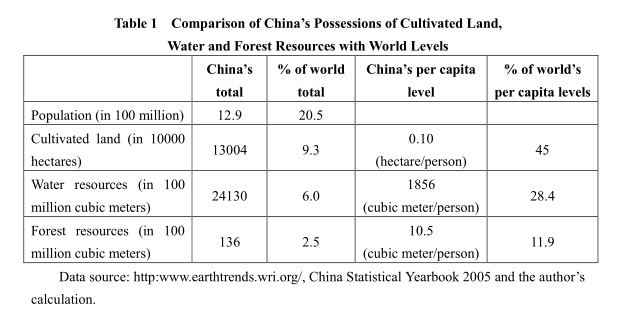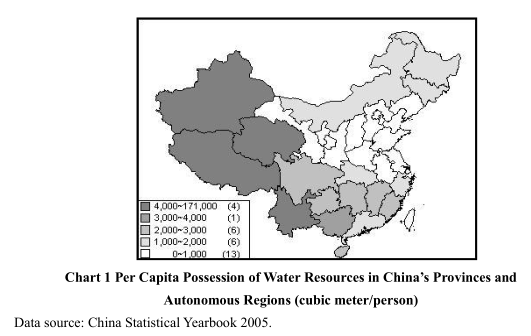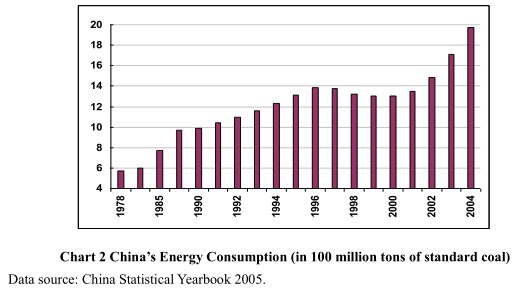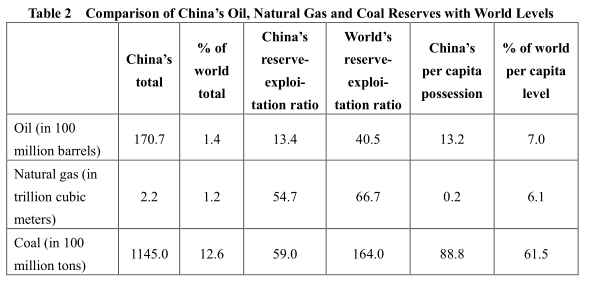The Basic Situation in China’s Primary Resources Supply and Demand and the Reform Direction of Resources Allocation Mechanism
Sep 11,2006
By Xuan Xiaowei
Research Report No 110, 2006
I. The Basic Situation in the Supply and Demand of China’s Natural Resources
1. Basic natural resources: cultivated land and water
China is a vast country with rich resources and a huge population. While the total amounts of natural resources[1] including cultivated land, water, forestry, energy and mineral reserves are fairly high, the per capita possessions are rather low. China’s cultivated land totals 1.3 billion hectares, accounting for 9 percent of the world total. Its water resources total 2.4 trillion cubic meters, accounting for 6 percent of the world total. Its forest resources total 13.6 billion cubic meters, accounting for 2.5 percent of the world total. But China has a population of about 1.3 billion, accounting for about 20 percent of the world total. When the huge total amount of various natural resources are divided by an even larger population, the result is that the per capita possession of natural resources is markedly lower than the world average level. As indicated by Table 1, China’s per capita cultivated land is about 0.1 hectare, or about 45 percent of the world level. 666 of the country’s over 2,800 counties are below the security line of a per capita possession of 0.05 hectares of cultivated land set by the United Nations Food and Agriculture Organization. China’s per capita possession of water resources is only 1,856 cubic meters, or only 28.4 percent of the world average level. According to the international evaluation indicators for measuring the shortage of water resources, the whole country is in a state of moderate water shortage. China’s per capita possession of forest resources is 10.5 cubic meters, less than 12 percent of the world average level.
The extremely uneven distribution of natural resources nationwide is another distinct feature of China’s natural resources. The vastness of China’s national territory and the dramatic differences in the geographic environment and conditions of various regions have led to the extreme unevenness of the natural resource distribution among various regions.

Take water resources for example, the most striking feature of China’s water resource distribution is that there is more water in the south but less in the north. Most of North China is in a state of water shortage (see Chart 1). Of all the Chinese provinces and autonomous regions, 13 are in a state of serious water shortage, where per capita possession of water resources is less than 1,000 cubic meters. And nearly all these provinces and autonomous regions are in North China.
Low per capita possession and extremely uneven distribution are two major features of the basic conditions of China’s basic natural resources. They have also caused the extremely unevenness of China’s population distribution and the corresponding uneven distribution of social and economic activities. More than 90 percent of the Chinese population live in the areas southeast of the line between Mohe in Heilongjiang Province and Tengchong in Yunnan Province. The vast northwestern region cannot support a large population because of the scarcity of basic natural resources (especially water and cultivated land). The concentration of population and economic activities greatly increases the pressure on the natural resources of the eastern region.
The total amount of land, water and other most basic natural resources are not expected to grow substantially. They could even drop somewhat. On the other hand, both of China’s population and economy have been growing rapidly. The result is that China would face increasingly tight constraints of natural resources in the future.

2. Energy resources
Energy resources constitute a fundamental guarantee for maintaining economic growth and social development. They are also one of the most important resources among all natural resources. Energy consumption has been going up steeply as a result of the rapid growth of the Chinese economy. Chart 2 indicates that China’s energy consumption rose from 570 million tons of standard coal in 1978 to 1,970 million tons of standard coal in 2004. In particular, energy consumption has been increasing at an average rate of about 13.5 percent since 2002. The strain between supply and demand in energy resources has been fairly evident.

Compared with water and cultivated land, China’s possession of energy resources is even more scarce. As indicated by Table 2, China’s oil reserve in 2004 was 17.07 billion barrels, accounting for only 1.4 percent of the world total. Its per capita possession of oil reserve was 13.2 barrels, or only 7 percent of the world average level. More importantly, China’s reserve-exploitation ratio was 13.4, which was far lower than the world level of 40.5. This means that at the current rate of exploitation, the length of time during which China’s existing reserve can sustain exploitation is far shorter than the world average level. In the future, China will depend more and more on external sources for its oil supply. China’s natural gas resources are also scarce. The reserve was 2.2 trillion cubic meters, accounting for 1.2 percent of the world total. Its per capita possession of natural gas reserve was only 6.1 percent of the world average level. Compared with oil and natural gas, China’s coal resources are much richer. Its reserve was 114.5 billion tons, accounting for 12.6 percent of the world total. Although coal is China’s richest resource reserve, its per capita reserve possession was only 88.8 tons, still below the world average level. China’s coal reserve-exploitation ratio was also far lower than the world average level. This is an indication that the prospect of the sustainable use of coal resources also allows no optimism.

Note: 1. The above resource reserves are the remaining proven reserves.
2. The reserve-exploitation ratio refers to the reserve divided by the exploitation in the same year. It means the number of years, during which the existing reserve can sustain the current pace of exploitation.
3. The above data and indicator interpretation all originated from the BP Statistical Review of World Energy 2005.

The distribution of energy resources is also very uneven nationwide. In general, there are more resources in the north and less in the south, which is exactly the opposite to the distribution of water resources. The situation has greatly increased the pressure on the construction of transport facilities huge amounts of energy resources have to be transported over long distances. A related problem is that a considerable amount of energy resources may be wasted in the transport process.
Overall, it has become increasingly difficult for China’s domestic energy supply, its supply of oil resources in particular, to meet the needs of the country’s fast economic development. This shortage will become more and more serious in the future.
…
If you need the full text, please leave a message on the website.
--------------------------------------------------------------------------------
[1] According to the classification of resources economics, the natural resources on Earthcan be divided into depletable, exhaustible and un-recyclable energy resources (petroleum, natural gas, coal and uranium), the recyclable resources (minerals), the replenishable but exhaustible resources (water), reservable and renewable resources (forests and grasses), the renewable resources (farm crops, fish and other organisms), and special resources (arable land). In our discussions, we simply classify the natural resources into the basic natural resources (cultivated land and water), the energy resources (petroleum, natural gas and coal), and mineral resources (various metal mineral resources). Please see: Tom Tietenberg (2004): Environmental and Natural Resource Economics (6ed). Landon: Addison Wesley.














